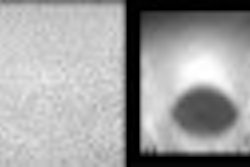Many women don’t have a clinical breast exam (CBE) before screening mammography, even if their primary care physician knows of a family history of breast cancer, according to a study from the Medical University of South Carolina in Charleston.
Both CBE by a healthcare provider and self-breast examination (SBE) by the patient are components of routine breast cancer screening, said Dr. Lisa Baron in a presentation at the 2001 RSNA meeting. At Baron’s institution, a written order for a mammogram is required of the referring physician. The assumption is that the referring doctor has conducted a CBE before requesting a screening exam, she said.
"As we know, yearly screening mammography is indicated for asymptomatic women, aged 40 and above. We also know that 15%-20% of all the cancers that are palpable we might not see on the mammogram. We observe a significant number of (patients referred for screening) who come in with large masses. We wanted to investigate the actual use of the CBE within 12 months prior to the screening mammogram," she said.
Self-administered questionnaires were given to women before screening mammography from August 2000 to March 2001. The one-page survey was completed by 1,135 women. Information on age, race, education, health insurance, family history, CBE and SBE practices, and healthcare providers was collected. The women were grouped into two categories: white and nonwhite, consisting of black, Hispanic, and other races, Baron said.
Of the women responding to the survey, 62% were white and 38% were nonwhite. The mean age of respondents was 53. Of the 1,135 responders, 95% answered the questions regarding CBE. Of these, 51% indicated that they had not undergone CBE within one year of screening mammography.
The demographic breakdown was as follows:
- 27% were white
- 30% were nonwhite
- 30% never attended college
- 20% attended at least some college
- 9% had a family history of breast cancer
- 40% had no family history of breast cancer
- 42% had health insurance
- 8% had no health insurance
Baron and her colleagues made note of two important results. First, a family of history of breast cancer still did not result in a CBE.
"We thought maybe if the patient had a family history of breast cancer, the referring physician would be more apt to do a CBE. But overall, only 52% of our patients got the CBE. Family history of breast cancer was not a predictor of having a CBE," Baron said.
Second, they found that older women were even less likely to have undergone CBE a year prior to screening mammography, "which is amazing because as a patient ages, their risk of breast cancer increases," she said.
Baron also reported that while the gender of the referring physician was not a factor in determining when a patient received a CBE, the doctor's specialty was. Ob/gyns performed CBE 59% of the time; family practitioners, 44%; and surgeons, 42%.
In summary, Baron said that only 50% of the patients coming to her institution had undergone CBE. A family history of breast cancer did not increase the likelihood of a CBE. CBE was even less likely if any of the following demographics were present: (Patients) were nonwhite, older, referred by a doctor other than an ob/gyn, less educated (regardless of race), or uninsured.
Baron concluded that radiologists need to continually educate the medical and lay communities about the importance of CBE and SBE in conjunction with mammography screening.
"Patients may have clinically evident, undocumented breast pathology in a normal mammogram," she said. "The question that this raises is: Are we truly performing thorough breast cancer screening?"
By Shalmali PalAuntMinnie.com staff writer
April 24, 2002
Related Reading
Socioeconomic status effects US breast cancer care more than race, April 4, 2002
Grassroots groups address high breast cancer rate among immigrants, March 30, 2001
Race-specific breast cancer detection rates announced, October 20, 2000
Researchers around the world seek solutions to increase breast cancer screening, April 17, 2000
Copyright © 2002 AuntMinnie.com



















